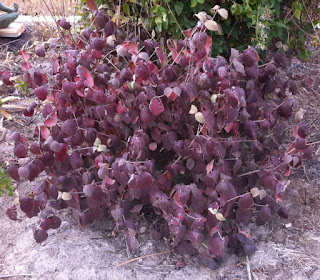.jpg) How the heck have I missed making 'Comte de Chambord' a focus of discussion in this blog??? Somewhere, somehow, I've overlooked one of the most dependable roses of my back landscaping border, a pleasure to have and to hold and to smell. She is one of my favorite roses, prominently displayed out in front of my Kon Tiki statue since 2003, alongside her garden-mate, 'La Reine', whose violet tones she reflects in her blush pink petals as an expression of love.
How the heck have I missed making 'Comte de Chambord' a focus of discussion in this blog??? Somewhere, somehow, I've overlooked one of the most dependable roses of my back landscaping border, a pleasure to have and to hold and to smell. She is one of my favorite roses, prominently displayed out in front of my Kon Tiki statue since 2003, alongside her garden-mate, 'La Reine', whose violet tones she reflects in her blush pink petals as an expression of love. 'Comte de Chambord' is a pink-blend Portland rose, one of the few of this class that I've been able to find and grow. She was bred by Robert and Moreau in or around 1858, a cross of 'Baronne Prevost' and 'Portland Rose'. 'Comte de Chambord' has relatively small blooms in my garden, about 3-4 inches in diameter. but they are very full of petals (50+ petals), and of fragrance, with a sweet, strong aroma. She's at her most beautiful in Spring and Fall in cooler weather, when the color is medium pink with a trace of blue, but in the midst of Summer she pales to almost white and she wrinkles terribly with the sun. In fact, I've questioned that I have the right rose for the name because of the small size of the blooms and the paleness in my garden compared to some descriptions of the rose, but I received my specimen from a trustworthy mail-order source. Once in a while, she'll even show her Damask background and have a bit of a green pip visible at her center. Sources on the Internet list her as tall, like my specimen, but Peter Beals, in Classic Roses, has her as only 3' X 2' and also lists her introduction later, in 1863.
'Comte de Chambord' is a real garden shrub, with a vase-like shape staying at about 4-5 feet tall in my garden. I trim about 6 inches off her top every Spring, but that's about all the care she requires; no spraying or fussing with this rose. She is cane-cold hardy in my garden, never exhibiting any winter dieback. I see about five or six bloom cycles before Winter shuts her off every year. All in all, a trouble-free and gorgeous rose.
'Comte de Chambord' is the mother of 'Gertrude Jekyll', the first of the English roses, but none other than Paul Barden says he prefers the mother to the offspring, and I agree. 'Comte de Chambord' is a fine rose for the garden, and I recommend adding her to yours as one of the best ambassadors of the Portland class. And by the way, I'm amiss in calling 'Comte' a she. No less tha Jeri Jennings noted in a Gardenweb post that 'Le Comte' would be a gentleman, while a female would be 'Le Comtesse'.







.jpg)
.jpg)
.jpg)
.jpg)
.jpg)